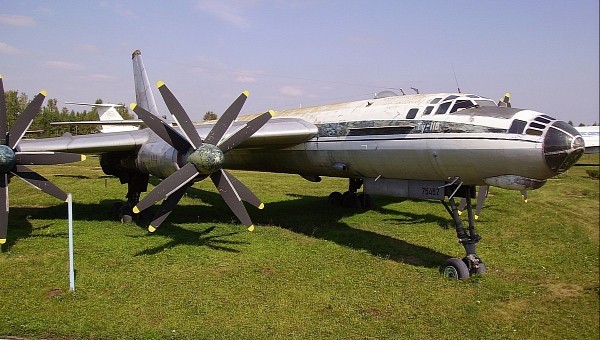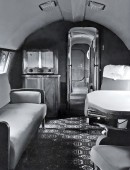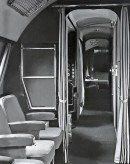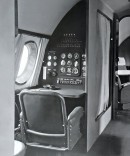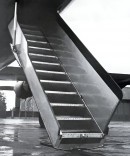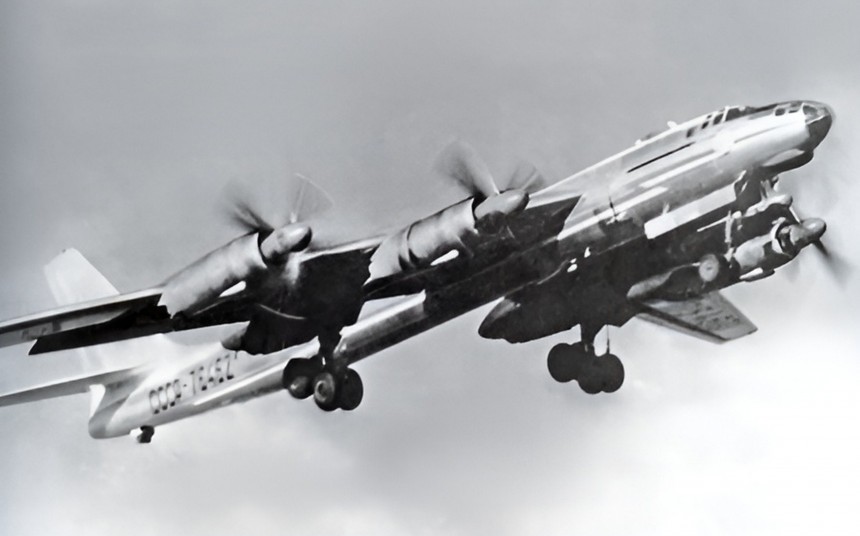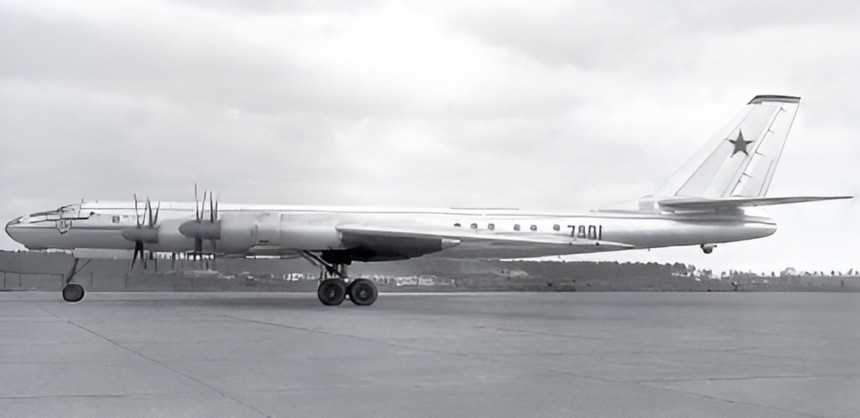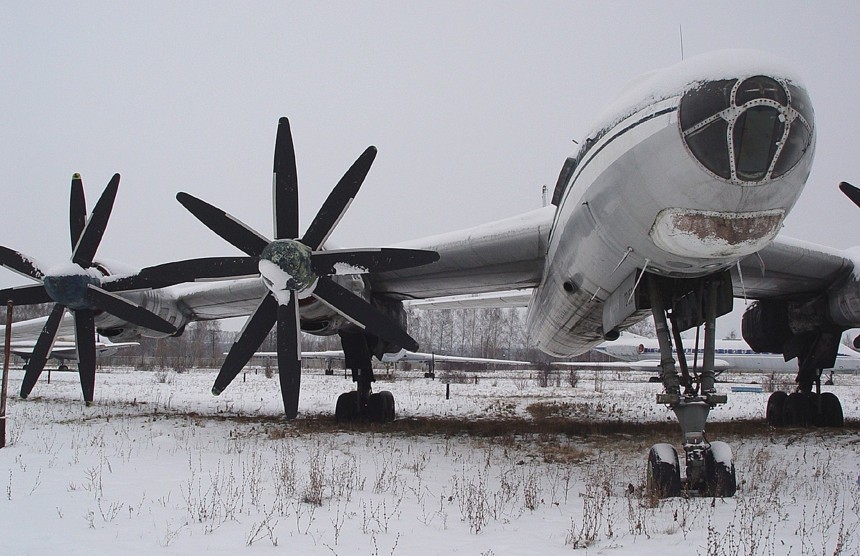Allow us to paint the scene for you. The year is 1957, and you're an average pencil pusher Politburo-Red Air Force liaison at a frosty airport in Vladivostok. For the last decade or more since the end of the Great Patriotic War, you've traveled back and forth between your home and Moscow either by train or a Lend-Lease American DC-3 if you were lucky. But today, you're about to fly something altogether different.
As you walk to the gate window, your eyes fill with the sight of something you've never seen before. Or at least, it still looks awfully similar to those Tu-95 bombers you've been seeing take off from military bases in your area recently. "But it can't be," you think to yourself. It must just be a trick of the eye.
But seriously? An airliner fashioned out of the same airframe as a nuclear-capable bomber? That's the most Soviet thing we've heard in a long time. But the reasons why Tupolev went down this route is not based in the USSR or even the Eastern Bloc, but rather a desire to offer something resembling an olive branch to western nations at odds with the Kremlin.
By 1957, Joseph Stalin had already been dead for three years. But the stench of the most savage dictatorship to plunder Eastern Europe in its history still permeated every move the communist lynchpin state made in its international affairs. General secretary Nikita Khrushchev knew the situation all too well. He himself aided in orchestrating the executions of some of Stalin's more loyal and psychotic associates, like the head of the NKVD secret police Lavrentiy Beria.
The threat of a madman known to have committed numerous unspeakable and heinous crimes rising to power was now eliminated. As such, the time for change had arrived. All that was needed was for Khrushchev to personally arrive in the west and spread the word. But there was a problem. An official state visit by the Khrushchev regime by the Eisenhower administration was scheduled for 1959.
And so, two separate airframes were proposed, both based on the prerequisite Tu-95 (NATO Codename: Bear). One was the Tu-114 passenger liner which average civilians flew on. Meanwhile, the Tu-116 took the same airframe and replaced bulk passenger seating with a bespoke VIP pressurized cabin compartment, complete with all the fittings a Soviet Head of State could require on a transatlantic flight.
Both airliners were to be developed concurrently and share a majority of important components to streamline maintenance and keep a steady supply of spare parts for both variants. Because time was of the essence, both Tu-116s were not built from fresh airframes but two existing Tu-95 bombers.
In April of that year, the first of two Tu-116s took to the skies for the first time. With dimensions of 46.17 meters (151 ft 6 in) long and a 54.1-meter (177 ft 6 in) wingspan, the Tu-116 fit snuggly within the lines of its strategic bomber cousin. But of course, the cabins of the two couldn't be more different.
The passenger compartment of the Tu-114/116 fit conveniently where the bomb bay was located in the Tu-95. Interestingly, there wasn't a means of accessing the cockpit of the Tu-116 from the passenger compartment. Messages to and from the cockpit between the pilots and the flight crew were passed via a novel pneumatic tube system where questions were answered via pencils and paper.
Re-worked vertical and horizontal control surfaces like bigger stabilizers and larger flaps were hoped to help refine the flight mannerisms of what once was a military jet where creature comforts were an afterthought. The wings were also slightly lower to the ground to accommodate a fully pressurized cabin. Despite the odds, the results were pretty impressive.
Everything from extra flight crew to a dedicated in-flight cook could find their way inside this lower deck. The first Tu-116 produced was built with a six-to-eight-passenger cabin configuration. At the same time, the second was equipped for three high-level VIP passengers. It's believed the second VIP variant was more in line with what Nikita Kruschev intended to fly to meet Eisenhower.
Theoretically, a Tu-116 could have accommodated as many as 24 passengers, complete with flight attendants, a cook, and up to 12 armed soldiers. Powered by the same Kuznetsov NK-12MV turboprop engines that pushed the Tu-95 bomber, Tu-114s and 116s opted for a cruising speed of 900 km/h (560 mph). Even in 2023, that's competitive with the cruising speeds of modern turbofan airliners. But at least you can watch a movie in a modern Airbus or Boeing without the engines interrupting you.
You can't say that about these twin Tupolevs. The NK-12 engine is notorious for its contra-rotating propeller tips touching the speed of sound as they cut through the air. If that sounds like a recipe for making the devil's own noise, you'd be right. In fact, the civilian Tu-114 was notorious for its engine vibrations making beverages do the cha-cha slide right off people's in-flight drinks trays.
The Tu-116's air stair system exited not out the side of the fuselage as with almost any other jetliner. But rather, it was integrated into the rear cargo door. Meaning that the Premiere of the Soviet Union and the global ambassador for communism would have exited the Tu-116 just like a dog doing its business on someone's front lawn. Not something all that desirable when you want to look stately on enemy soil.
Khrushchev demanded that he be able to fly the Tu-114 with its conventional air stair arrangement to his U.S. state visit in September 1959. To its credit, the airliner performed more or less flawlessly on that visit. That didn't mean the Soviet Navy wasn't tracking the plane like a hawk as it made its way across the North Atlantic. Khrushchev never stepped foot inside the Tu-116 to anyone's knowledge.
Instead, the two existing airframes were given back to the Red Air Force and served as utility airplanes until the 1990s. Today, only a single example remains intact. It's on display at the Ulyanovsk Aircraft Museum next to the Ulyanovsk Baratayevka Airport in western Russia, where it currently rots back into the ground from whence it came. If you ask most who know of this frankenliner, they'd say that was for the best.
Check back soon for more vintage aviation profiles here on autevolution.
A luxury VIP transport based on a bomber
Little does this hypothetical Soviet bureaucrat know their airliner for that evening has its roots not as a bespoke VIP airliner but as a bomber. One that was designed to pulverize the enemies of Stalin and later Malenkov, Bulganin, and Khrushchev. It still menaces Russia's enemies to this very day. This is the story of the Tupolev Tu-116But seriously? An airliner fashioned out of the same airframe as a nuclear-capable bomber? That's the most Soviet thing we've heard in a long time. But the reasons why Tupolev went down this route is not based in the USSR or even the Eastern Bloc, but rather a desire to offer something resembling an olive branch to western nations at odds with the Kremlin.
By 1957, Joseph Stalin had already been dead for three years. But the stench of the most savage dictatorship to plunder Eastern Europe in its history still permeated every move the communist lynchpin state made in its international affairs. General secretary Nikita Khrushchev knew the situation all too well. He himself aided in orchestrating the executions of some of Stalin's more loyal and psychotic associates, like the head of the NKVD secret police Lavrentiy Beria.
Making an impact in a short time frame
Not exactly a lot of time to develop an entire bespoke VIP transportation platform, a la a communist Air Force One. It routinely takes a decade or more for passenger airliners to get off the ground from scratch. Thankfully, Tupolev didn't have to start from scratch. The Tu-95 quad-engine turboprop strategic bomber, which entered service in 1956, was the perfect platform for an airliner. At least, on the surface, it was.And so, two separate airframes were proposed, both based on the prerequisite Tu-95 (NATO Codename: Bear). One was the Tu-114 passenger liner which average civilians flew on. Meanwhile, the Tu-116 took the same airframe and replaced bulk passenger seating with a bespoke VIP pressurized cabin compartment, complete with all the fittings a Soviet Head of State could require on a transatlantic flight.
Both airliners were to be developed concurrently and share a majority of important components to streamline maintenance and keep a steady supply of spare parts for both variants. Because time was of the essence, both Tu-116s were not built from fresh airframes but two existing Tu-95 bombers.
Based on an icon of Soviet aviation
Over time, the looming date for Kruschev to meet the west made the Tu-116 take manufacturing precedence over the Tu-114. This was especially the case when it became clear the Tu-114 might not be finished in time. Ironically, a flood of military orders took precedence over the entire Tu-114/116 project and pushed back its deployment into 1957.In April of that year, the first of two Tu-116s took to the skies for the first time. With dimensions of 46.17 meters (151 ft 6 in) long and a 54.1-meter (177 ft 6 in) wingspan, the Tu-116 fit snuggly within the lines of its strategic bomber cousin. But of course, the cabins of the two couldn't be more different.
The passenger compartment of the Tu-114/116 fit conveniently where the bomb bay was located in the Tu-95. Interestingly, there wasn't a means of accessing the cockpit of the Tu-116 from the passenger compartment. Messages to and from the cockpit between the pilots and the flight crew were passed via a novel pneumatic tube system where questions were answered via pencils and paper.
Re-worked vertical and horizontal control surfaces like bigger stabilizers and larger flaps were hoped to help refine the flight mannerisms of what once was a military jet where creature comforts were an afterthought. The wings were also slightly lower to the ground to accommodate a fully pressurized cabin. Despite the odds, the results were pretty impressive.
An interior fit for a communist leader
Not many photos exist detailing the interior of Khrushchev's personal airliner, but what does exist shows stitched-leather couches complete with particularly Soviet-looking carpets anointed with hexagonal patterns like a Ukranian babushka's living room. Tu-114-based airliner variants were known for having a main passenger cabin and a lower service deck.Everything from extra flight crew to a dedicated in-flight cook could find their way inside this lower deck. The first Tu-116 produced was built with a six-to-eight-passenger cabin configuration. At the same time, the second was equipped for three high-level VIP passengers. It's believed the second VIP variant was more in line with what Nikita Kruschev intended to fly to meet Eisenhower.
Theoretically, a Tu-116 could have accommodated as many as 24 passengers, complete with flight attendants, a cook, and up to 12 armed soldiers. Powered by the same Kuznetsov NK-12MV turboprop engines that pushed the Tu-95 bomber, Tu-114s and 116s opted for a cruising speed of 900 km/h (560 mph). Even in 2023, that's competitive with the cruising speeds of modern turbofan airliners. But at least you can watch a movie in a modern Airbus or Boeing without the engines interrupting you.
You can't say that about these twin Tupolevs. The NK-12 engine is notorious for its contra-rotating propeller tips touching the speed of sound as they cut through the air. If that sounds like a recipe for making the devil's own noise, you'd be right. In fact, the civilian Tu-114 was notorious for its engine vibrations making beverages do the cha-cha slide right off people's in-flight drinks trays.
A dismal failure with impressive performance
But that alone wasn't what ensured the Tu-116 wouldn't make it to the planned trip to the U.S. The final nail in the coffin had nothing to do with an inherent engineering flaw in the design. In fact, the Tu-114/16 was perhaps the most reliable domestic Soviet airliner. Instead, the issue arose from how VIP guests were due to enter and exit the airplane.The Tu-116's air stair system exited not out the side of the fuselage as with almost any other jetliner. But rather, it was integrated into the rear cargo door. Meaning that the Premiere of the Soviet Union and the global ambassador for communism would have exited the Tu-116 just like a dog doing its business on someone's front lawn. Not something all that desirable when you want to look stately on enemy soil.
Khrushchev demanded that he be able to fly the Tu-114 with its conventional air stair arrangement to his U.S. state visit in September 1959. To its credit, the airliner performed more or less flawlessly on that visit. That didn't mean the Soviet Navy wasn't tracking the plane like a hawk as it made its way across the North Atlantic. Khrushchev never stepped foot inside the Tu-116 to anyone's knowledge.
Instead, the two existing airframes were given back to the Red Air Force and served as utility airplanes until the 1990s. Today, only a single example remains intact. It's on display at the Ulyanovsk Aircraft Museum next to the Ulyanovsk Baratayevka Airport in western Russia, where it currently rots back into the ground from whence it came. If you ask most who know of this frankenliner, they'd say that was for the best.
